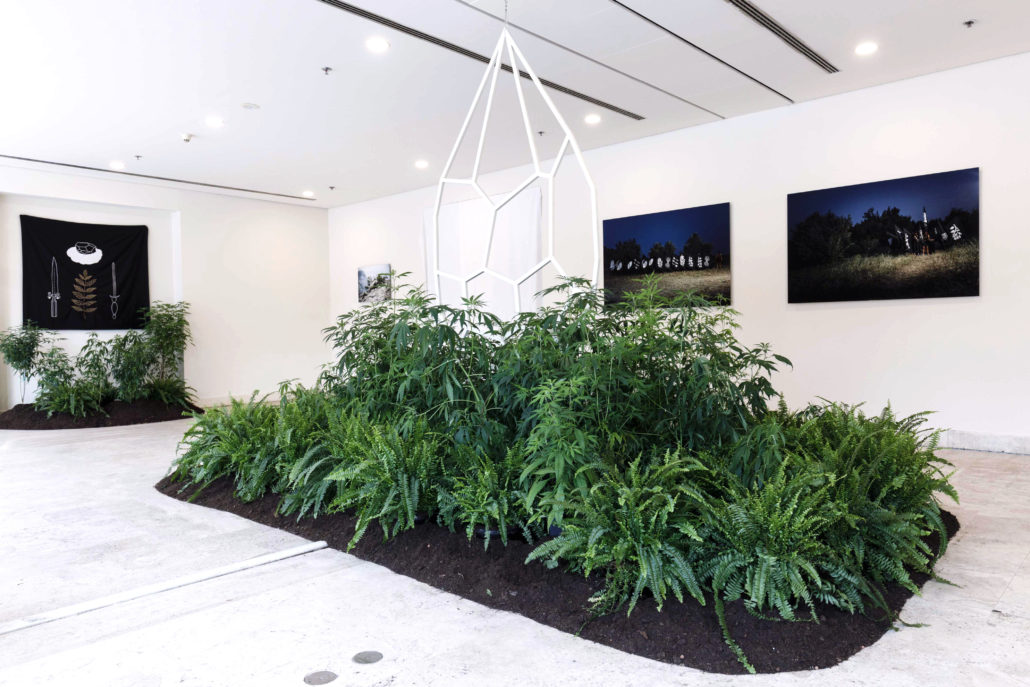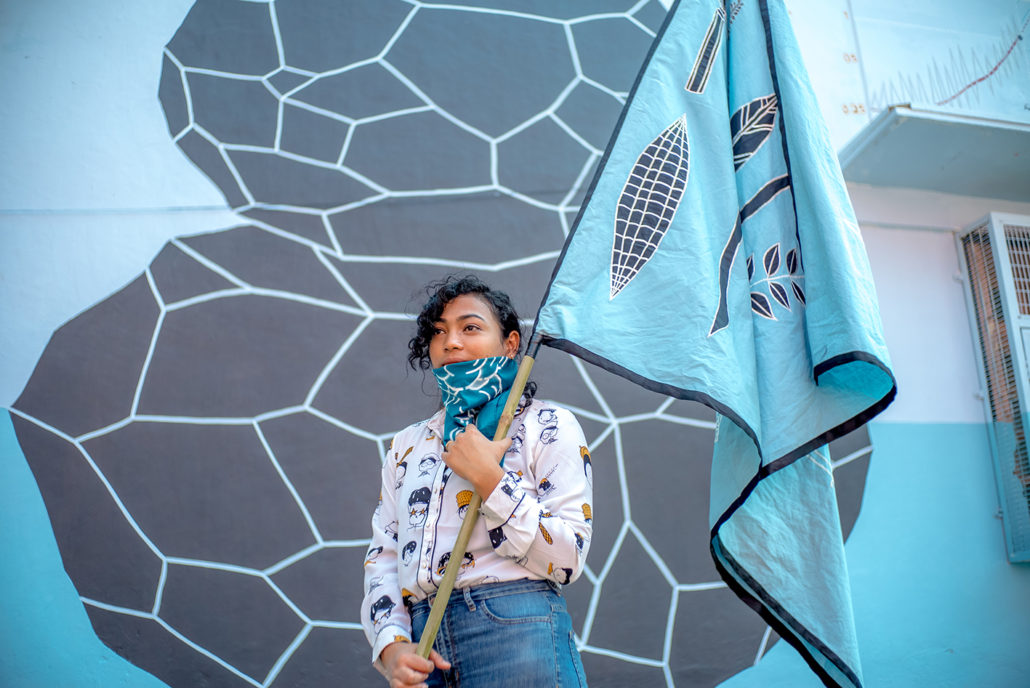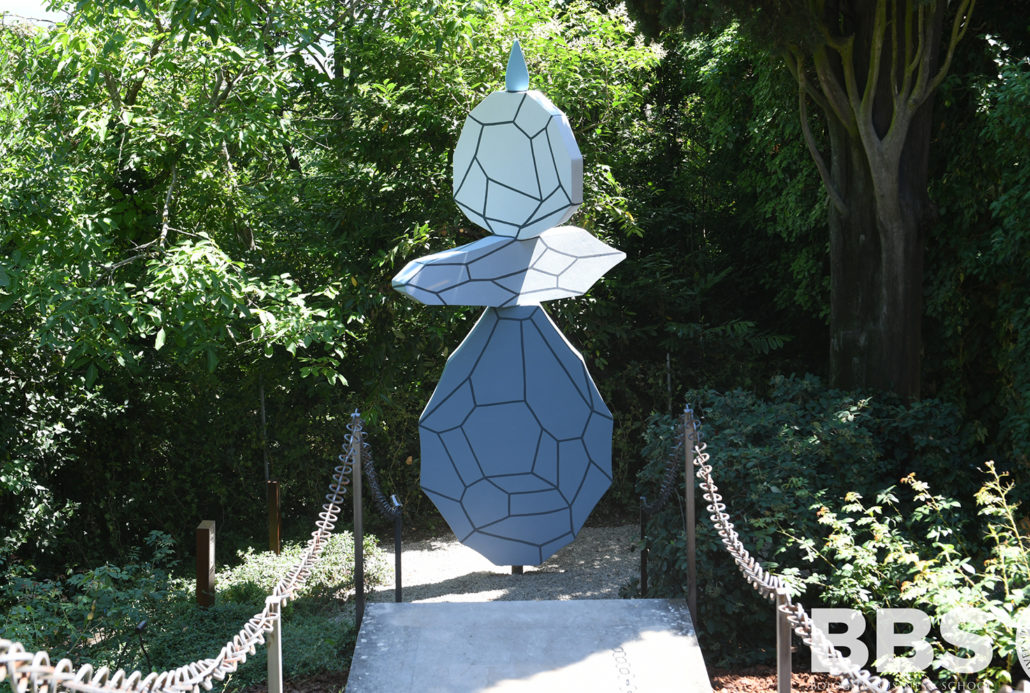New alliances with the ecosystems
Art, science and environment at the time of the climatic and pandemic crisis.
by Andrea Conte – Andreco – ( www.andreco.org / www.climateartproject.com)
Interview by Elena Posokhova. ( www.maritima01.com in collaboration with www.acquafundation.com )

Andreco. Photo: Fondazione Musica Per Roma, Musacchio, Ianniello & Pasqualini. Auditorium, Rome, 2019
The fundamental idea of all your creativity / research?
We are facing a global environmental and climatic crisis and my artwork is affected and informed by it.
My artistic research is multidisciplinary, influenced by science, environment, activism, anthropology, philosophy, social and political science and many other things.
Curiosity and complexity are part of my artwork concept.
An artwork is different from a communication campaign, or a piece of design, or a decoration: it is more similar to something that is between a magic ritual and a revolutionary act.
All my artworks are tributes to the ecosystem.

Andreco – Parade for the river Tiber. Produce by: Romaeuropa Foundation with Teatro dell’Opera di Roma, Accademia Nazionale Santa Cecilia for La festa di Roma di Roma Capitale. Rome, 2020
Your studio (where and how you work)
My studio is in Piazza Vittorio, a multicultural neighborhood near Termini Train station in Rome.
Three people are working at Studio Andreco at the moment, plus a network of six to twelve collaborators around the Climate Art Project, my main multidisciplinary project between art, science and environment.
Most of my work is site-specific so usually I travel from one location to another.

Andreco – Climate 04 – sea level raise – Photo: Like Agency. Venice, 2017
What is your opinion on the importance of the dialogue between scientists and artists (science and art)? Why is this necessary?
For me the dialogue between art and science is a natural process, I was an artist that became a scientist to then return to art. In general, I believe it is important to convey complex problems retaining both the complexity and the urgency at the same time.
A cultural revolution is necessary to face the global environmental, climatic and now also sanitary crisis.
People should be able to access environmental knowledge needed to understand and react to this crisis.
Scientific and environmental processes should be common ground, shared knowledge for citizens.
This cultural empowerment would make it difficult for the speculators to promote green wash and fake green deals and everybody would be more concerned with fighting for the ecosystem.
A cultural revolution means that everyone would understand that protecting the ecosystem means protecting ourselves, our health and our existence on this planet.

Andreco – Climate 01 – Production: GFR and Pigment Workroom. Ph: Mario Nardulli, Paris 2015
Your project in Paris? What was the message of the project? What artistic expression did you get?
I was called in Paris by two organizations – GFR and Pigment workroom – that asked me to create a public artwork for the COP21 UN conference on Climate Change, where the Paris Agreement for a reduction of emissions and an upper limit of 1.5°C temperature rise, was signed. The public artwork was named Climate 01.
I created a mural that symbolically represented the causes and the consequences of climate change in rue Richomme in la Goutte D’Or – the mural “points” to and draws attention to the underlying problem.
I then also worked on an installation in collaboration with le Jardin partagé Baudelaire – a collective of urban gardeners that transformed a vacant lot into a beautiful small garden.
The installation was made collectively within two workshops on wood construction and gardening and served the purpose of drawing attention to green solutions to the problems identified in the mural.
I also gave a number of lectures in a primary school to involve small children and at La Sorbonne as part of a series in Aesthetic Philosophy, on invitation of Professor Vittorio Parisi.
Paris is also where the Climate Art Project started – my itinerant project to raise awareness through contemporary art.

Andreco – Climate 01 – Jardin partagé Baudelaire – Production: GFR and Pigment Workroom. Ph: Alice Bettolo, Paris 2015
What art project would you like to implement in collaboration with scientists in the near future?
I am moving forward with my Climate Art Project, focusing on water, air pollution and now also about the impact of environmental and climatic crisis on health and on the propagation of epidemics.

Andreco – Future Landscape , installation view. Show, curated by Sara Alberani. Photo: Fondazione Musica Per Roma, Musacchio, Ianniello & Pasqualini. Auditorium, Rome, 2019
What project are you working on regarding the ecology or the environment of the Mediterranean? Why is this relevant?
I have worked on many projects related to the Mediterranean environment:
Climate 03 Desertification in Puglia, curated by Pigment Workroom, was related to the acceleration of the desertification phenomenon due to climate change; I did a wall painting inspired by the desertification maps and dedicated to the Tiblis river that is slowly disappearing.
Climate 04 in Venice was related to rising sea levels and extreme waves in the Adriatic sea.
The sculpture, “Cultivate Utopias”, I created in Cagliari as Gramsci memorial, realized for the festival Gramsci Camposud, curated by Maria Paola Zedda and Giulia Palomba, is made in iron and a small garden of Mediterranean plants chosen for their resilient properties as these need little water to survive.
Finally, the Parade for the river Tiber that occurred on the 1st of January 2020, was a performance dedicated to the main river of Rome, strictly connected to the Mediterranean environment. (More Photos and info)

Andreco- Landmark 02 – Climate 04 – Sea Level Raise – Ph: Giovanni Fiamminghi – Venice 2017
Would you be interested in establishing a dialogue with other contemporary artists? Why?
I collaborate with other artists, some of them are old friends now. We share views on the future societies.

Andreco. Climate 05, Reclaim Air and Water. Ph: Akshat Nauriyal. Production S+Art India Foundation and the Italian Institute of Culture, Delhi, India, 2019
What do you think about the quarantine measures introduced, will it really affect the state of the environment or is it impossible with such a short time?
The quarantine is needed to stop the propagation of the virus.
I hope the moment the lock down finishes also marks the end of this “state of exception” that has limited many of our fundamental rights of movement and privacy.
The business as usual trend of production was deviated by the virus and the air quality has improved.
My greatest hope is that we will not go back to the normal trend of polluting emissions because it is not sustainable for the environment, nor for the human life on the planet.

Andreco – Freshwater – BBS, Bologna Business School – University of Bologna 2018
Is it possible that a virus is a product of high pollution and climate change?
We can’t say that the virus is a direct consequence of high pollution, but there are some correlations.
The virus arose in the human population, migrating from wild animals – bats or pangolins as per the scientists – to humans in a process detailed in David Quammen’s book “Spillover”.
Position papers show a relation between highly polluted areas and the diffusion of COVID-19, but a direct connection is yet to be proven. Scientists are assuming that it is possible that the virus uses the PM5 or PM10 fine dust particles as a carrier to persist longer in the air. What has been proven is that in polluted areas, with high levels of fine dust particles PM2 – PM5, people are more subject to respiratory diseases.
The OMS estimate that in Italy 30k people died prior to Covid-19 as a result of diseases related to pollution.
Many other articles mention that the loss of biodiversity and the destruction of the wild forests facilitate the spillover of virus from wild animal to humans. (WWF report).
The virus may be a consequence of the destruction of biodiversity by the anthropic activity.
Other papers state that virus is a natural phenomenon to control the demography of parasites, and because humans exploit natural resources and destroy the planetary ecosystem, this is just a normal reaction of nature against the humans.
Saying that the virus is a direct consequence of the human pollution is an over- simplification, not proven by the science yet- in reality the question is more complex, but in certain ways there is a correlation between the virus’ propagation and the destruction of the environment.

Andreco – Climate 05, Reclaim Air and Water. Ph. Akshat Nauriyal. Production S+Art India Foundation and the Italian Institute of Culture, Delhi, India, 2019
Any other comments on the ecological situation of the Mediterranean.
In the midst of this global tragedy there is a positive sign – people are showing more solidarity with each other and this is a fundamental act for the conservation of the species.
I believe we need to respect the ecosystem we share with many other species of animals and plants. I think post Covid-19 we must start a different way of living, with more empathy, in synergy with the environment.
We need also a completely new economy – a circular bio-economy that considers the value of the natural capital and sustainable resource management as main driver for the decision making.
I believe we must move to a zero net carbon society by 2030 as our existence or our extinction depends on this.
Let’s build and consolidate strong alliances between the species and planetary ecosystems

Andreco – Parade for the river Tiber. Produce by: Romaeuropa Foundation with Teatro dell’Opera di Roma, Accademia Nazionale Santa Cecilia for La festa di Roma di Roma Capitale. Rome, 2020
Andrea Conte, in art Andreco, is a visual artist with a PhD in Environmental Engineering.
His post-doctoral research – a collaboration with the School of Engineering at the University of Bologna and Columbia University in New York City, was focused on Nature Based Solutions and green technologies for sustainable resource management in different climates. His artistic research is focused on the relationship between humans and ecosystems and between the built environment and the landscape. Andreco uses many techniques to present his art, from public installations to photos, videos or wall paintings, performances and drawings. Andreco has worked for several international festivals, museums and galleries
www.andreco.org – www.climateartproject.com – @andreco_

Andreco – Climate 05, Reclaim Air and Water. Ph. Federico Angeloni. Production S+Art India Foundation and the Italian Institute of Culture, Delhi, India, 2019



